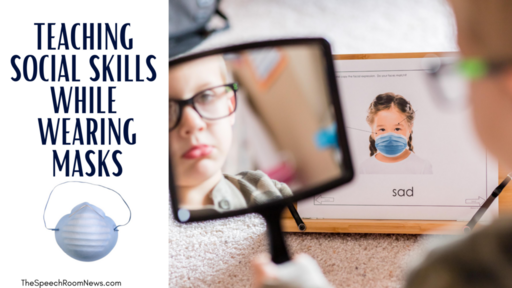
Since the first day I put on a mask, my head has been running a constant tally of the things I do differently with it on and how we can focus on teaching social skills while wearing masks to students. There are two huge issues for mask-wearing and communication: being heard and the impact on non-verbal social skills. Social skills are one of my favorite things to teach kids. I’ve used sticky notes and emojis before so tackling masks is right up my ally!
Facial Expressions
In the United States, we rely heavily on facial expressions of the whole face. Covering it with a mask changes the interpretations of social cues we use to interact daily. Luckily, our brains are smart and we can adjust with mask covering. The research also tells us that we rely on a variety of information, including tone of voice (Paulmann and Uskul 2014), body language (Aviezer et al 2012), and contextual cues (Aguert et al 2013) to read another’s emotions. So although we don’t have a full face, we can use other forms to both communicate and understand others. It’s critical to teach these social skills while wearing masks and shields.
Hearing
All types of masks impact hearing. In a recent study, audiologists compared a simple paper mask and N95 masks. The data showed that each mask essentially serves as a low-pass filter, attenuating the high frequencies (2000-7000 Hz) spoken by the wearer, with the decibel (dB) level of attenuation ranging from 3 to 4 dB for a simple medical mask and close to 12 dB for the N95 masks. (Goldin et al 2020).
In addition to the reduced amplification, mask wearing takes away the ability to read lips. This often helps us clarify what we’re hearing.
Teaching Social Skills to Students in Masks
So we clearly have a problem, what can we do? Explicit instruction is important for students. We need to teach them how to communicate with a mask to that a communication partner can hear them. When communicating they need to:
- speak slowly
- reduce background noise
- get the person’s attention before speaking
- check for understanding while taking turns in conversation.
- use more gestures
- watch the eyes for clues about feelings.
I made a free printable to help students remember these cues. There is a list version and a version with visual supports.
Before we teach students about masks, we need to teach them about reading facial expressions. We can teach students to for patterns in the facial features.
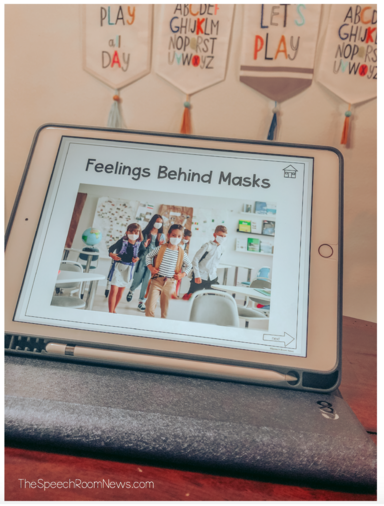
For example, when we are angry our eyebrows come closer together and our mouths tighten. When we’re confused, our eyebrows come together again but we might only move one side of our mouths. We pair these small facial movements with the tone of voice, body language, and the situation in order to make an inference about another person’s feelings.
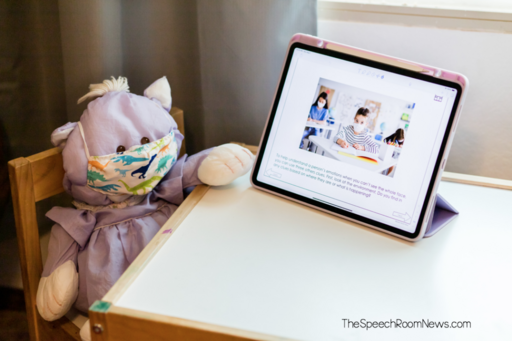
Start by showing students pictures of children with different emotions. Point out the features and identify the body parts that give the clues to the emotion. Look at the context clues and see how they can help the student identify the emotion.
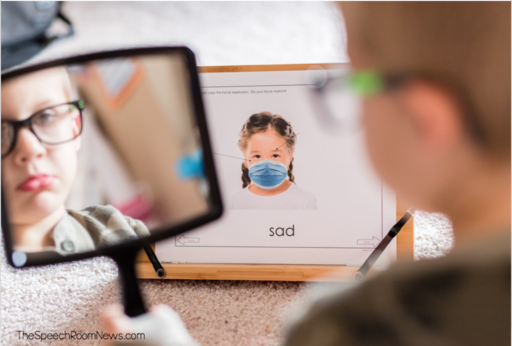
After students can identify facial expressions, we can work on helping them understand some of the cues that are just visualized through the eyes. In the image above, the girl’s eyes look sad but we can’t see her lips. When a student looks in a mirror and copies an expression they improve their ability to identify the emotion of others. A mirror is a powerful tool. This boy can compare how his eyes look compared to the girl on screen.
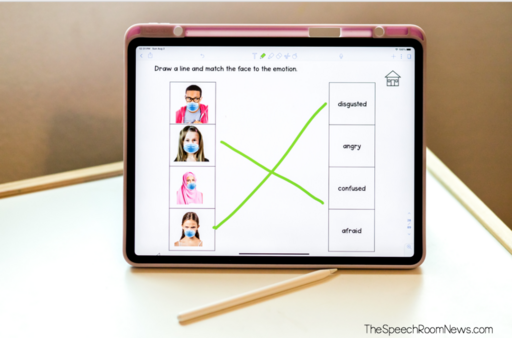
Next, we pair that with the tone of voice, body language, and contextual cues students can more easily make a judgment about a person’s emotions. We can practice these skills in several ways using matching practice and comparing several faces on one page.
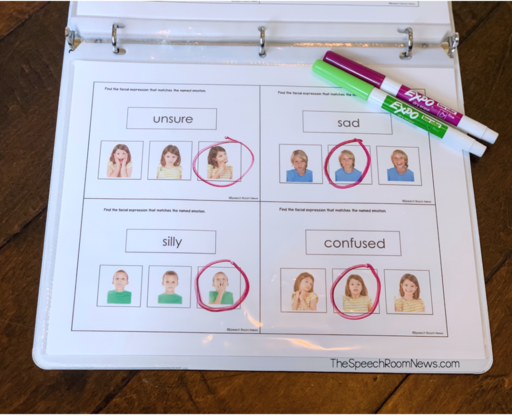
Last, students can make their own task cards where they take photos of themselves showing different emotions. Comparing two faces on the same person provides some differentiation and makes the task a bit easier.
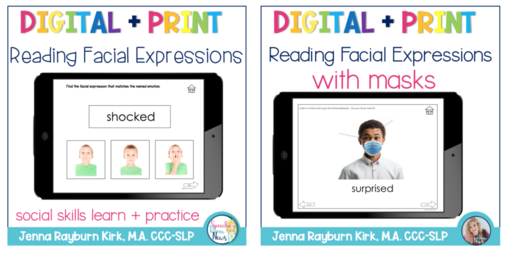
You can access the resources demonstrated in the photos on this page in the Facial Expressions packet and a Facial Expressions with Masks packet in my store. Each one contains both the digital and print versions.
- Aguert M, Laval V, Lacroix A, Gil S, and Le Bigot L. 2013. Inferring emotions from speech prosody: not so easy at age five. PLoS One. 8(12):e83657.
- Aviezer H, Trope Y, and Todorov A. 2012. Body cues, not facial expressions, discriminate between intense positive and negative emotions. Science. 338(6111):1225-9.
- Goldin A, Weinstein BE, Shiman N. How do medical masks degrade speech perception? Hearing Review. 2020;27(5):8-9.
- Paulmann S and Uskul AK 2014. Cross-cultural emotional prosody recognition: Evidence from Chinese and British listeners. Cogn Emot. 28(2):230-44.
- Sato W, Fujimura T, Kochiyama T, and Suzuki N. 2013. Relationships among facial mimicry, emotional experience, and emotion recognition. PLoS One. 8(3):e57889.
Join the SRN newsletter!

I'm so glad you stopped by! If you'd like to keep up with the newest posts and get exclusive free downloads, please sign up for the newsletter! Your first freebie is ready as soon as you subscribe and confirm your email!

Thank you for this great information!!
I have one request for information please?
I have a deaf and Hard of Hearing colleague who cannot get a clear mask for himself and I
I interpret for him during a faculty meeting or during a conference our school system has for all staff.
Where is the best resource for a clear mask that they will NOT fall apart so quickly??
Amazon has several but those have arrived with terrible quality and fall apart quickly!
THANK YOU HELP PLEASE!! KIDS RETURN MONDAY!!
So far this has been my favorite: Humanity Shield https://www.rapidresponseppe.com/
The population I serve is composed of all D/HH students many teachers and staff.
Don’t know what the experience will be like when wearing it during an entire school day or if it will hold up to a 5days a week sort of use.
Haven’t tried that out yet.
Here is the link to the mask with the bandanna strap over the nose 6 piece $14.99 and $3.99 shipping: https://www.amazon.com/Visible-Expression-Reusable-Transparent-Hearing/dp/B08C7ZLS1L/ref=sr_1_17?crid=2DJTDKRBQ54YI&dchild=1&keywords=masks+for+deaf+and+hard+of+hearing&qid=1597770538&sprefix=masks+for+dea%2Caps%2C256&sr=8-17
This is a good option for D-HH as well and after trying the larger face shield if you can wear something smaller that is my preference
Hi there,
This company also makes GREAT masks for the deaf and hard of hearing. I live and work in Canada, but I thought I’d share in case you’re looking for other possibilities. They are on the government approved list for PPE. Proceeds from the sale of each mask are also donated to the Canadian Hard of Hearing Association:
https://www.thecomofoundation.ca/
Thank you for the info! I purchased the Reading Facial E xpressions with masks bundle. Also requested the free download poster – it has not been sent in an email and I cannot find it on your site to print. please help.
Hello,
Thank you for the great information! I am an undergraduate student studying to become a speech-language pathologist and have been curious as to how instruction has changed since the pandemic. I never truly understood how much we rely on facial expressions to communicate a message. It is amazing that they have an option where the examples on the task cards are wearing masks. This challenges the student to identify cues visualized through just the eyes. Would you recommend using these methods in teletherapy as well?